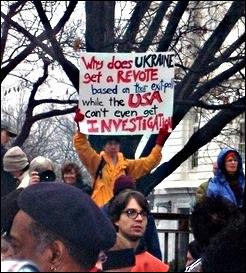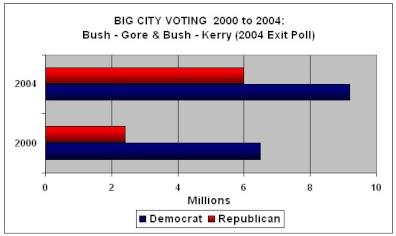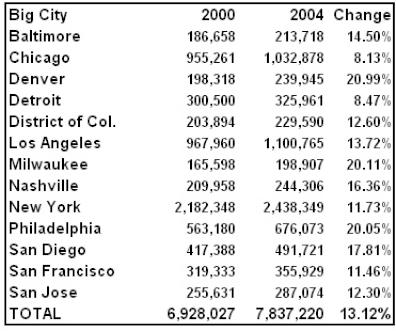Exit Poll Mess - 2008

Opposing the Ohio electors --Capitol Hill, Jan. 6, 2005 - Michael Collins cc.
The Past is Prolog
Michael Collins
"Scoop" Independent News
(Wash. DC) Did you know that 2004 was not a "red versus blue" election? Did any analysis that you heard or read mention that the very red rural voting segment went from 23% of the vote total in 2000 to 16% in 2004? How about the 2.4 million fewer votes Bush received in the smaller 2004 rural segment than in 2000? All of this showed up in the exit polls on Election Day and the day after when the "official" exit poll was released.
The national exit polls are sponsored by the National Election Pool (media consortium) consisting of ABC, CBS, CNN, FOX, and NBC, and the Associated Press. The polling is conducted for the media consortium by Edison - Mitofsky. The same day poll for federal elections seeks to capture who voted, where, and why.*
The exit poll gave us another surprise, one that was necessary for the poll to match up with the announced vote totals showing Bush winning by a 3 million vote margin, 50.7% to 48.3%.
2004 turnout across the country ran about 16% over 2000. The big cities had a 66% increase in turnout if we are to believe the exit polls. In the exit poll analysis, big cities are those with half a million or greater population. That 66% increase in turnout took the 9 million big city vote total from 2000 to 15 million in 2004. Bush got just under 4 million more votes in the big cities in 2004 that he did in 2000. White big city voters went from 5 million in 2000 to nine million in 2004, a remarkable 80% increase

Do you believe this? Nearly 4 million new votes for Bush in the big cities in 2004!
What was going on? Who were these nearly 4.0 million new white big city voters and where did they come from? They were white "ghosts" who emerged from that 66% turnout "measured" by the exit poll, marching toward the polls like extras in the "Thriller" video. That's the only place they could have come from because they've never been seen before or since.
They were a necessary fiction required to balance out the official exit poll and allow it to be "adjusted" to fit the final vote count. Given the 16% turnout increase for the nation, isn't it reasonable to assume something proximate in the big cities? But that's not what happened. The turnout increase in the big cities was beyond belief but barely noticed.
The 2000 Democrat - Republican big city split of 71% to 26% was comparable to the history of big city party preferences in presidential elections. But in 2004, that changed to 60% Democrat - 39% Republican with Bush more than doubling his 2000 vote. Is there some event that explains that this sudden spike in Bush votes and turnout in the big cities?
The only event that caused this was the internal adjustment of big city exit poll figures and percentages by the media consortium sponsored exit pollsters.
The exit poll had to match the vote count?
How could the vote count be wrong?
Go looking for actual big city vote totals and you're likely to hear that they're really not possible to break out since votes are counted by the counties. That's correct for 40% of the big city population but for 60%, you can get discrete big city totals. You just go to state and city boards of elections web sites and read the totals. When you do that for the majority of big city voting, guess what? The 2004 big city turnout increase was only 13% over that of 2000.

From state and local board of elections data (see footnotes)
This 66% turnout increase and all those white "ghosts" made a real difference in how the exit polls explained the 2004 election results.

Comparison of 2004 big city totals using the pollsters 66%
and 13% based on the 60% sample of actual big city results
Using the 2000 big city vote total from that exit poll, we start with 9.2 million votes. The 66% turnout increase gives Bush nearly 5 million more votes compared to the actual figure of a 13% increase in big city turnout. That's what allowed Bush to "win it" in the big cities.
Why did the exit pollsters use 66% when the actual vote totals in the chart above were available election night or the next day? All the media consortium's pollsters had to do was get on the internet or turn on the television in the New York City area to get a turnout sample from a city of 8 million people. In fact, all the network consortium had to do was call up a few of their affiliates in the big cities listed above.
All of this was pointed out in considerable detail in two articles in 2007 (see links below). Since that time, have the exit pollsters and the media consortium changed their final poll to correct the clearly demonstrated error in big city turnout for 2004? Have they apologized to the public for this obviously inaccurate finding? Of course not. Had they done so, they would have demonstrated that the 13,000 plus national sample on Election Day confounded the reported results of the election.
It would have been a bold statement that there something very wrong with the 2004 election results, i.e., the election was almost certainly stolen.
Don't bet on the exit polls to do anything other than ratify an election based on deliberate discrimination that systematically eliminates poor and minority voters, flawed voting machines subject to tampering, and vote counting that takes place in secret, conducted by private vendors with strong Republican sympathies.
Permission to reproduce part of this entire article
granted with attribution of authorship, a link to this
article, and acknowledgement of images, where
indicated.
* This analysis uses
data from the final revised national exit poll issued the
afternoon of Nov. 3, 2004. The first graph and other
figures presented come from the 2000 and 2004 national exit
poll, with the exception of the chart of the actual vote
counts in the 13 big cities listed. The sources for those
figures are indicated in the footnotes section of "Election 2004:
The Urban Legend."
N.B. This article is a summary of
"Election 2004: The Urban Legend" by the author, based on
original research by internet poster anaxarchos, to whom I owe a debt of
gratitude.
For the whole story, see:
Election 2004: The Urban Legend, Michael
Collins July 13, 2007
Notes from the Underground, Michael Collins
Aug. 22,
2007


 Binoy Kampmark: The Strawman Of Antisemitism - Banning Protests Against Israel Down Under
Binoy Kampmark: The Strawman Of Antisemitism - Banning Protests Against Israel Down Under Gordon Campbell: On The Coalition’s Empty Gestures, And Abortion Refusal As The New Slavery
Gordon Campbell: On The Coalition’s Empty Gestures, And Abortion Refusal As The New Slavery Keith Rankin: Judaism, Antisemitism, And Israel
Keith Rankin: Judaism, Antisemitism, And Israel Ian Powell: Haka, Hikoi And The Empowerment Of The Kohanga Generation
Ian Powell: Haka, Hikoi And The Empowerment Of The Kohanga Generation Binoy Kampmark: Feeding Chaos - Israel Cripples Syria’s Defence
Binoy Kampmark: Feeding Chaos - Israel Cripples Syria’s Defence The Conversation: News Bargaining Incentive:
The Conversation: News Bargaining Incentive: